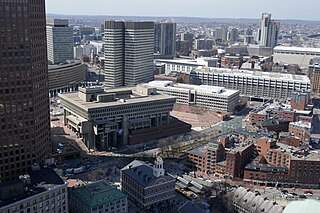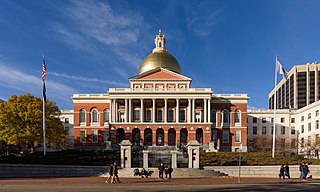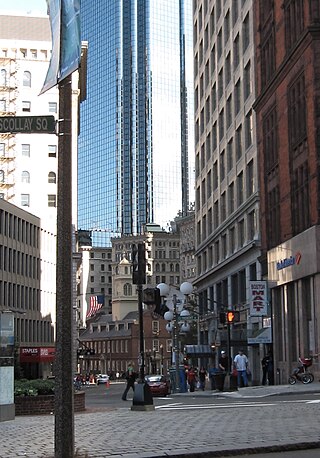
Charles Bulfinch was an early American architect, and has been regarded by many as the first American-born professional architect to practice.

Government Center is an area in downtown Boston, centered on City Hall Plaza. Formerly the site of Scollay Square, it is now the location of Boston City Hall, courthouses, state and federal office buildings, and a major MBTA subway station, also called Government Center. Its development was controversial, as the project displaced thousands of residents and razed several hundred homes and businesses.

Government Center station is an MBTA subway station in Boston, Massachusetts. It is located at the intersection of Tremont, Court and Cambridge Streets in the Government Center area. It is a transfer point between the light rail Green Line and the rapid transit Blue Line. With the Green Line platform having opened in 1898, the station is the third-oldest operating subway station in the MBTA system; only Park Street and Boylston are older. The station previously served Scollay Square before its demolition for the creation of Boston City Hall Plaza.

Beacon Hill is a historic neighborhood in Boston, Massachusetts, United States. It is also the location of the Massachusetts State House. The term "Beacon Hill" is used locally as a metonym to refer to the state government or the legislature itself, much like Washington, D.C.'s Capitol Hill does at the federal level.

The Massachusetts State House, also known as the Massachusetts Statehouse or the New State House, is the state capitol and seat of government for the Commonwealth of Massachusetts, located in the Beacon Hill neighborhood of Boston. The building houses the Massachusetts General Court and the offices of the Governor of Massachusetts. The building, designed by architect Charles Bulfinch, was completed in January 1798 at a cost of $133,333, and has repeatedly been enlarged since. It is one of the oldest state capitols in current use. It is considered a masterpiece of Federal architecture and among Bulfinch's finest works, and was designated a National Historic Landmark for its architectural significance.

New Chardon Street is a street in downtown Boston, Massachusetts, United States, north of Government Center. It begins at Cambridge Street at Bowdoin Square, across from Bowdoin Street. The two-way street continues east across Congress Street, ending at Haymarket Square with access to the Sumner and Callahan Tunnels and the Central Artery, as well as local access to Washington Street North and the Surface Artery.

Solomon Willard was a carver and builder in Massachusetts who is remembered primarily for designing and overseeing the Bunker Hill Monument, the first monumental obelisk erected in the United States.

Bowdoin station is a Massachusetts Bay Transportation Authority (MBTA) rapid transit station in Bowdoin Square in Boston, Massachusetts. The station is the downtown terminus of the Blue Line, part of the MBTA subway system. It has a single wedge-shaped island platform located inside a balloon loop. Bowdoin is the only Blue Line station that is not accessible.

Asher Benjamin was an American architect and author whose work transitioned between Federal architecture and the later Greek Revival architecture. His seven handbooks on design deeply influenced the look of cities and towns throughout New England until the Civil War. Builders also copied his plans in the Midwest and in the South.

Bowdoin Street in Boston, Massachusetts, extends from the top of Beacon Street, down Beacon Hill to Cambridge Street, near the West End. It was originally called "Middlecott Street" as early as the 1750s. In 1805 it was renamed after the Governor James Bowdoin.

The West End is a neighborhood of Boston, Massachusetts, United States, bounded generally by Cambridge Street to the south, the Charles River to the west and northwest, North Washington Street on the north and northeast, and New Sudbury Street on the east. Beacon Hill is to the south, North Point is across the Charles River to the north, Kendall Square is in Cambridge across the Charles River to the west, and the North End of Boston is to the east.

Kirk Boott was an American industrialist who was instrumental in the early history of Lowell, Massachusetts.

St. Stephen's Church is a historic church in the North End of Boston, Massachusetts. It was built in 1802–1804 as the New North Church or New North Meeting House and was designed by the noted architect Charles Bulfinch. It is the only one of the five churches he designed in Boston to remain extant. The church replaced one which had been built on the site in 1714 and enlarged in 1730. The Congregationalist church became Unitarian in 1813, and the church was sold to the Roman Catholic Diocese in 1862, and renamed St. Stephen's. It was restored and renovated in 1964-65 by Chester F. Wright, and was added to the National Register of Historic Places in 1975.

The Brattle Street Church (1698–1876) was a Congregational and Unitarian church on Brattle Street in Boston, Massachusetts.

Revere House (1847–1912) was an upscale hotel in 19th-century Boston, Massachusetts, located on Bowdoin Square in the West End. Fire destroyed the building in 1912.

Court Street is located in the Financial District of Boston, Massachusetts. Prior to 1788, it was called Prison Lane (1634–1708) and then Queen Street (1708–1788). In the 19th century it extended beyond its current length, to Bowdoin Square. In the 1960s most of Court Street was demolished to make way for the construction of Government Center. The remaining street extends a few blocks, near the Old State House on State Street.

Gardiner Greene (1753–1832) was a cotton planter and merchant from Boston, Massachusetts who conducted business from his plantation, Greenfield, in Demerara (Guyana) in the late 18th and early 19th centuries. Socially prominent in the town of Boston, he owned a house, greenhouse, and garden filled with fruit trees and peacocks on Cotton Hill, opposite Scollay Square. He was also the son-in-law of painter John Singleton Copley.

Mount Vernon Church in Boston, Massachusetts, was a Congregational church located on Beacon Hill (1844–1891) and later in Back Bay (1892–present).

Richard Bond (1798–1861) was an early American architect who practiced primarily in Boston, Massachusetts.





























